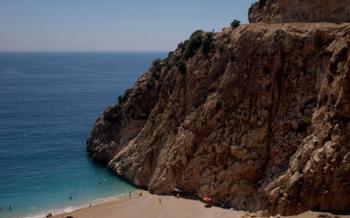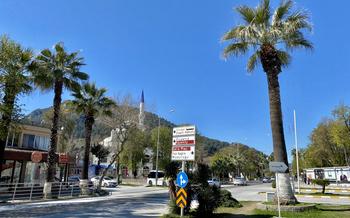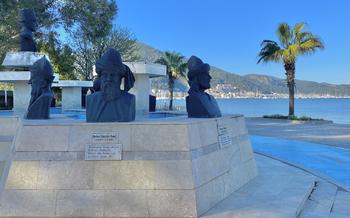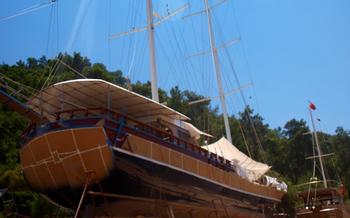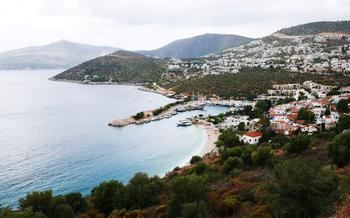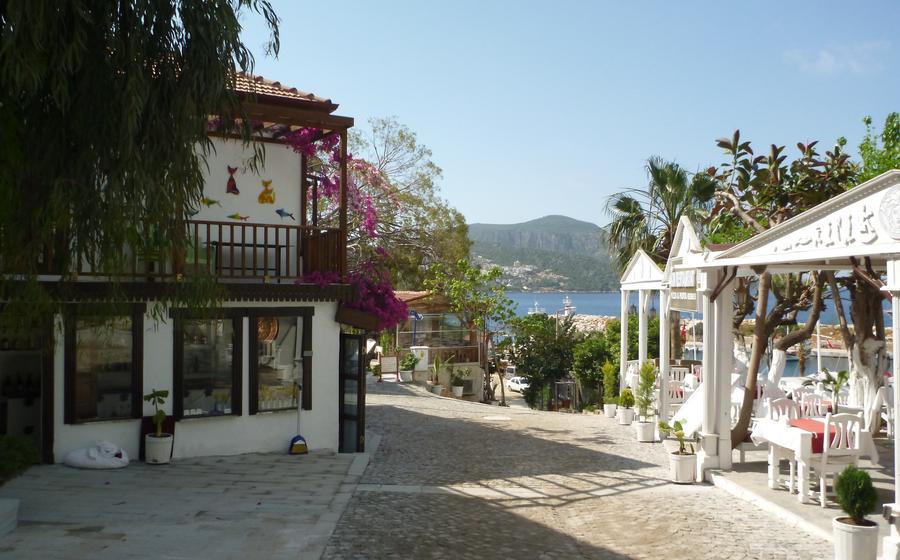
Arycanda Ancient City
- Arycanda Ancient City: An Overview
- Exploring the Ruins
- Architectural Marvels
- Religious Sites
- Engineering Ingenuity
- Arycanda's Acropolis: A Majestic Citadel
- Stunning Mosaics
- UNESCO World Heritage Site
- Nearby Attractions
- Things to Bring
- Arycanda Museum: A Treasury of Arycanda's Past
- Best Time to Visit
- Guided Tours
- Solo Exploration
- Insider Tip: Unveiling Hidden Treasures
Arycanda Ancient City: An Overview
Arycanda, an ancient city located in the picturesque region of Kalkan, Turkey, holds a significant place in the history and culture of the Lycian civilization. Founded in the 4th century BC, Arycanda flourished as a prosperous trading center and an important religious site, attracting visitors from across the Mediterranean. Over the centuries, it underwent the rule of various empires, including the Persians, Greeks, and Romans, each leaving their mark on its architecture and cultural heritage.
Archaeological excavations, initiated in the early 20th century, have unearthed a treasure trove of artifacts, providing valuable insights into the city's past. From intricate mosaics to impressive sculptures, these discoveries have shed light on Arycanda's artistic prowess and its role as a hub of cultural exchange.
Today, Arycanda stands as a testament to the ingenuity and artistry of its ancient inhabitants. Visitors can explore its well-preserved ruins, immerse themselves in the city's rich history, and marvel at the architectural wonders that have stood the test of time.
Exploring the Ruins
Venturing through the ruins of Arycanda is like stepping back in time. Explore the city walls, which once provided protection and a sense of security to its inhabitants. The gates, once bustling with activity, now stand as silent guardians of the city's past.
In the heart of Arycanda lies the agora, the ancient marketplace. Imagine the lively atmosphere as merchants displayed their wares, and residents bartered for goods. The bouleuterion, or council chamber, echoes with the voices of past debates and decisions that shaped the city's destiny.
Architectural Marvels
Amidst the ruins of Arycanda, several architectural marvels stand as testaments to the city's grandeur and advanced civilization. One of the most impressive structures is the theater, capable of accommodating up to 1,500 spectators. Its well-preserved stage, intricate carvings, and stunning acoustics offer a glimpse into the city's vibrant cultural life.
Another architectural highlight is the nymphaeum, an elaborate fountain house that once served as a public gathering place. Its ornate facade, adorned with sculptures and inscriptions, reflects the city's artistic prowess. The odeon, a smaller theater designed for musical performances and poetry recitals, further showcases the city's love for the arts.
These architectural masterpieces, with their remarkable preservation and intricate details, provide a fascinating glimpse into the daily life and cultural achievements of ancient Arycanda.
Religious Sites
Arycanda was a deeply religious city, as evidenced by the numerous temples and shrines that dot its ruins. The most prominent of these is the Temple of Apollo, located in the heart of the city. This well-preserved temple features an impressive facade with intricate carvings depicting scenes from Greek mythology. Inside, visitors can admire the remains of the altar and the cella, where the cult statue of Apollo once stood.
Another significant religious site in Arycanda is the Temple of Zeus, located on the city's acropolis. This temple, dedicated to the king of the gods, offers stunning views of the surrounding countryside. Although in ruins, the temple's foundations and columns still stand tall, providing a glimpse into the grandeur of ancient Arycanda.
Finally, the Temple of Aphrodite, the Greek goddess of love and beauty, is located just outside the city walls. This smaller temple features a well-preserved altar and a series of intricate carvings depicting scenes of love and seduction. Visitors to the Temple of Aphrodite can also enjoy the surrounding gardens, which offer a peaceful retreat from the hustle and bustle of the city.
These temples, along with numerous smaller shrines and altars scattered throughout the ruins, provide a testament to the deep religious beliefs of the ancient Arycandians. They offer a fascinating glimpse into the spiritual life of this once-thriving city.
Engineering Ingenuity
Beyond its architectural wonders, Arycanda showcases remarkable engineering feats that attest to the ingenuity of its ancient inhabitants. The city's aqueduct system stands as a testament to their mastery of water management. This intricate network of channels and pipes ensured a reliable supply of fresh water to the city's residents, even during dry seasons.
The necropolis, or cemetery, offers a glimpse into Arycanda's funerary practices. Elaborate tombs and mausoleums line the outskirts of the city, showcasing various architectural styles and providing insights into the beliefs and social customs of the Arycandians.
Finally, the cistern, a large underground reservoir, served as a vital water storage facility. This engineering marvel ensured that the city had a constant supply of water, even during periods of drought or siege.
Arycanda's Acropolis: A Majestic Citadel
Perched atop a hill overlooking the ancient city, Arycanda's acropolis served as a formidable defensive bastion and a seat of power. Its strategic location provided a panoramic vista of the surrounding region, allowing the city's rulers to keep a watchful eye on their domain. The acropolis was heavily fortified, with thick walls and sturdy towers guarding its perimeter. Within these walls lay the remains of the citadel, once the heart of Arycanda's administrative and military operations. Though time has taken its toll, the remnants of grand structures and intricate fortifications still stand, hinting at the grandeur and power that once resided here. Climbing to the acropolis is a rewarding experience, not only for the historical insights it offers but also for the breathtaking views that unfold before your eyes. From this vantage point, you can gaze upon the sprawling ruins of Arycanda, the shimmering Mediterranean Sea in the distance, and the lush Taurus Mountains that form a majestic backdrop to this ancient city.
Stunning Mosaics
The ruins of Arycanda are adorned with intricate and well-preserved mosaics that offer a glimpse into the city's artistic heritage. These mosaics, which adorn the floors of various buildings, depict mythological scenes, geometric patterns, and everyday life. The artistry and craftsmanship displayed in these mosaics are truly remarkable, showcasing the skill and talent of the ancient artisans.
One of the most impressive mosaics is located in the agora, where a large panel depicts the Triumph of Dionysus, the Greek god of wine and revelry. The mosaic portrays Dionysus riding a chariot pulled by four panthers, surrounded by a procession of satyrs and maenads, his followers. The vivid colors and dynamic composition of this mosaic make it a true masterpiece of ancient art.
Another notable mosaic can be found in the nymphaeum, a fountain house. This mosaic depicts Narcissus, a young man who fell in love with his own reflection. The mosaic shows Narcissus gazing at his reflection in a pool of water, surrounded by flowers and plants. The intricate details and the use of shading in this mosaic create a sense of depth and realism that is truly captivating.
These mosaics not only serve as decorative elements but also provide valuable insights into the beliefs, mythology, and artistic traditions of the ancient Arycandians. They are a testament to the cultural richness and sophistication of this ancient city and continue to inspire and awe visitors to this day.
UNESCO World Heritage Site
Arycanda's exceptional cultural and historical significance has earned it the prestigious recognition of being designated as a UNESCO World Heritage Site. This accolade not only acknowledges the city's outstanding universal value but also ensures its protection and preservation for future generations.
Arycanda meets several criteria for inclusion on the World Heritage List, including its exceptional representation of a significant stage in human history. The city's well-preserved ruins provide a glimpse into the urban planning, architecture, and artistic achievements of the ancient Lycians.
To ensure the ongoing protection and conservation of Arycanda, UNESCO has collaborated with local authorities and organizations to implement comprehensive management plans. These plans encompass measures for the restoration and maintenance of the site, the establishment of visitor facilities, and the promotion of sustainable tourism practices.
As a result of these efforts, Arycanda stands as a testament to the enduring legacy of the Lycian civilization and serves as a valuable resource for archaeologists, historians, and visitors from around the world.
Nearby Attractions
Beyond Arycanda's ancient wonders, the region offers a wealth of captivating destinations. The picturesque beach town of Kalkan, with its charming harbor and crystal-clear waters, is a must-visit. Indulge in sun-soaked relaxation on the pristine beaches or embark on thrilling water sports adventures.
Journey to the ancient city of Patara, renowned for its well-preserved ruins and stunning beach. Explore the remains of the ancient city, including the impressive amphitheater, and lose yourself in the beauty of the golden sands.
For nature enthusiasts, the Saklikent Gorge is an unforgettable experience. Hike through the breathtaking canyon, surrounded by towering rock walls, and immerse yourself in the tranquility of this natural wonder.
Complement your exploration of Arycanda with visits to these nearby attractions to create a truly comprehensive and memorable travel experience.
Things to Bring
Comfortable Shoes for Walking:
Arycanda is a sprawling ancient city with uneven terrain, so comfortable shoes are a must for navigating the ruins. You'll be doing a lot of walking, so make sure your shoes provide good support and traction. Avoid sandals or flip-flops, as they can be slippery and uncomfortable on rough surfaces.
Sun Protection and Water:
The Mediterranean sun can be intense, especially during the summer months. Be sure to bring sunscreen, a hat, and sunglasses to protect yourself from the harmful rays. It's also important to stay hydrated, so bring a reusable water bottle and refill it throughout the day.
A Camera to Capture the Ruins:
Arycanda is a photographer's paradise, with its well-preserved ruins and stunning surroundings. Bring a camera to capture the beauty of the ancient city and the breathtaking views from the acropolis. You'll want to document your visit and share your photos with friends and family.
Arycanda Museum: A Treasury of Arycanda's Past
Nestled in the heart of Kalkan, the Arycanda Museum stands as a testament to the rich history and vibrant culture of the ancient city. Within its walls, a treasure trove of artifacts and exhibits awaits visitors, offering a glimpse into Arycanda's glorious past.
As you step through the museum's doors, you are greeted by an array of captivating displays that narrate the city's story. From intricate pottery and sculptures to inscriptions and coins, each artifact tells a tale of Arycanda's artistry, craftsmanship, and economic prowess.
Among the highlights of the collection are the stunning mosaics that once adorned the floors of Arycanda's grand buildings. These intricate works of art depict mythological scenes and everyday life, offering a glimpse into the minds and beliefs of the city's inhabitants.
The museum also houses a collection of architectural fragments, including columns, capitals, and friezes. These remnants of Arycanda's once-magnificent structures provide insight into the city's architectural style and the skill of its builders.
A visit to the Arycanda Museum is an essential complement to exploring the ancient city itself. Here, you can delve deeper into Arycanda's history, gain a greater appreciation for its cultural heritage, and leave with a lasting impression of this remarkable place.
Location and Visiting Hours: The Arycanda Museum is conveniently located in the center of Kalkan, within easy walking distance of the ancient city. It is open to the public daily from 9:00 AM to 5:00 PM, except on Mondays.
Insider Tip: To make the most of your visit, consider booking a guided tour of the museum. A knowledgeable guide can provide insightful explanations of the exhibits and bring Arycanda's history to life.
Best Time to Visit
The ideal time to visit Arycanda is during the shoulder seasons, from April to May and from September to October. During these months, the weather is pleasant and warm, with average temperatures ranging from 15 to 25 degrees Celsius. The crowds are also smaller, allowing for a more immersive and tranquil exploration of the ruins.
To truly experience the charm of Arycanda, consider visiting early in the morning or late in the afternoon, when the soft, golden light of the rising or setting sun casts a magical glow on the ancient stones. The cooler temperatures and fewer visitors during these times will enhance your experience and allow you to fully appreciate the beauty and serenity of the site.
Guided Tours
Joining a guided tour of Arycanda Ancient City offers several advantages to enhance your exploration. Professional guides, often experts in ancient history and archaeology, provide insightful commentary and explanations as you walk through the ruins. They can point out specific features, tell stories about the city's past, and answer any questions you may have. Guided tours often follow a structured itinerary, ensuring that you cover all the highlights of the site and don't miss any important landmarks.
Some tour operators even offer tailor-made itineraries, allowing you to customize your visit based on your interests and time constraints. This flexibility enables you to focus on specific aspects of the city, such as its architectural marvels, religious sites, or engineering ingenuity. Whether you're a history buff, an architecture enthusiast, or simply curious about ancient civilizations, a guided tour can deepen your understanding and appreciation of Arycanda Ancient City.
Solo Exploration
For those who prefer to wander at their own pace, Arycanda offers a rewarding experience for solo travelers. Embark on a self-guided tour, armed with a map or guidebook, to uncover the secrets of the ancient city. Take your time to explore each nook and cranny, marveling at the intricate details and imagining the lives of those who once called Arycanda home.
Tips for Independent Travelers:
-
Do your research: Familiarize yourself with the history and layout of Arycanda before your visit. This will enhance your understanding and appreciation of the ruins.
-
Plan your route: Decide which areas you want to focus on and create a route that allows you to see the highlights without missing anything important.
-
Bring a camera: Capture the beauty of the ruins and the surrounding landscape. Your photos will serve as lasting memories of your adventure.
-
Engage with locals: Strike up conversations with locals to gain insights into the history and culture of Arycanda. They may share stories and recommendations that you wouldn't find in any guidebook.
-
Be respectful: Remember that Arycanda is a historical site, and it is essential to be respectful of the ruins and the local customs.
Insider Tip: Unveiling Hidden Treasures
As you wander through the ruins of Arycanda, keep an eye out for secret spots that offer breathtaking views and hidden gems waiting to be discovered. One such spot is the secluded viewpoint nestled among the ancient walls, where you can witness a mesmerizing panorama of the surrounding landscape. Another hidden gem is the inconspicuous chamber beneath the theater, where you can marvel at the intricate acoustics and imagine the vibrant performances that once took place here.
To immerse yourself in the authentic essence of Arycanda, seek out the local recommendations for traditional Turkish cuisine. Indulge in a delectable meal at a family-run restaurant, savor the flavors of freshly caught seafood at a charming harborside eatery, or sip aromatic Turkish coffee while enjoying the vibrant atmosphere of a local café. These culinary experiences will undoubtedly enhance your journey through time and provide a deeper connection to the rich cultural heritage of Arycanda.


